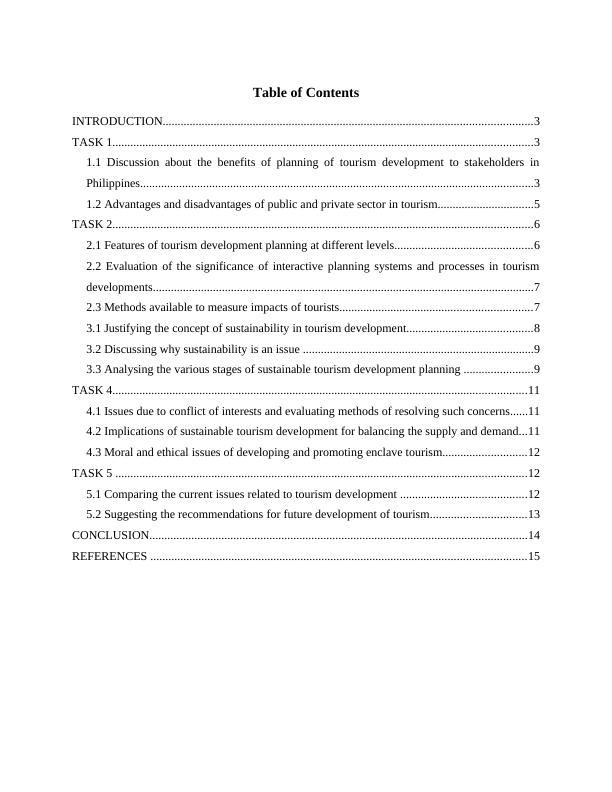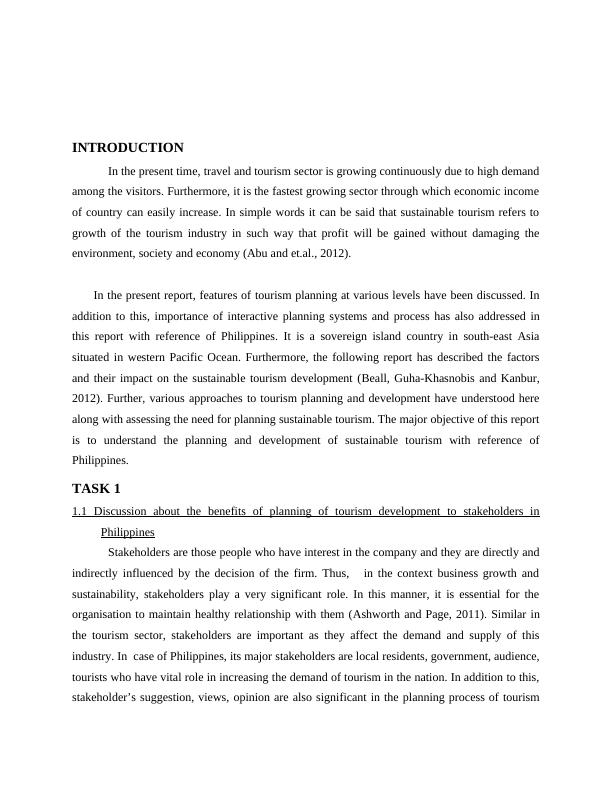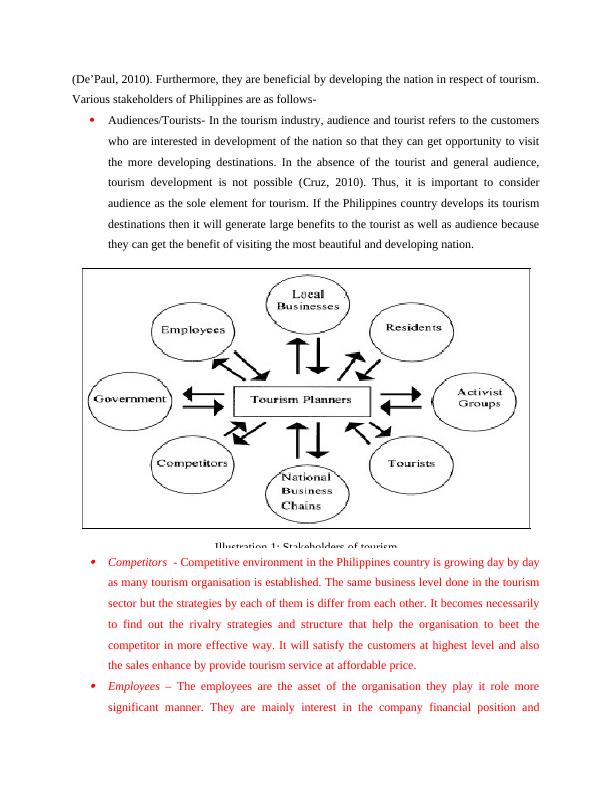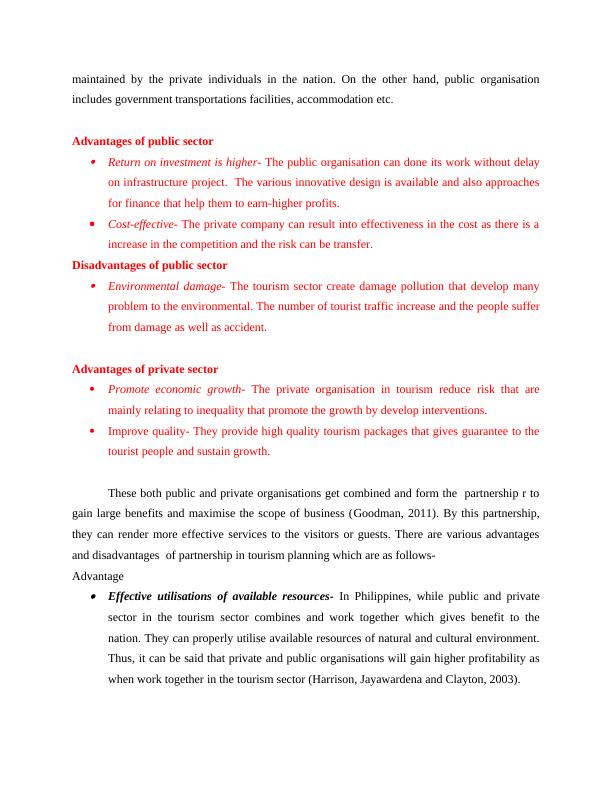Stages Of Sustainable Tourism
21 Pages4880 Words61 Views
Added on 2020-01-23
Stages Of Sustainable Tourism
Added on 2020-01-23
ShareRelated Documents
Sustainable Tourism

Table of Contents
INTRODUCTION...........................................................................................................................3
TASK 1............................................................................................................................................3
1.1 Discussion about the benefits of planning of tourism development to stakeholders in
Philippines...................................................................................................................................3
1.2 Advantages and disadvantages of public and private sector in tourism................................5
TASK 2............................................................................................................................................6
2.1 Features of tourism development planning at different levels..............................................6
2.2 Evaluation of the significance of interactive planning systems and processes in tourism
developments...............................................................................................................................7
2.3 Methods available to measure impacts of tourists................................................................7
3.1 Justifying the concept of sustainability in tourism development..........................................8
3.2 Discussing why sustainability is an issue .............................................................................9
3.3 Analysing the various stages of sustainable tourism development planning .......................9
TASK 4..........................................................................................................................................11
4.1 Issues due to conflict of interests and evaluating methods of resolving such concerns......11
4.2 Implications of sustainable tourism development for balancing the supply and demand...11
4.3 Moral and ethical issues of developing and promoting enclave tourism............................12
TASK 5 .........................................................................................................................................12
5.1 Comparing the current issues related to tourism development ..........................................12
5.2 Suggesting the recommendations for future development of tourism................................13
CONCLUSION..............................................................................................................................14
REFERENCES .............................................................................................................................15
INTRODUCTION...........................................................................................................................3
TASK 1............................................................................................................................................3
1.1 Discussion about the benefits of planning of tourism development to stakeholders in
Philippines...................................................................................................................................3
1.2 Advantages and disadvantages of public and private sector in tourism................................5
TASK 2............................................................................................................................................6
2.1 Features of tourism development planning at different levels..............................................6
2.2 Evaluation of the significance of interactive planning systems and processes in tourism
developments...............................................................................................................................7
2.3 Methods available to measure impacts of tourists................................................................7
3.1 Justifying the concept of sustainability in tourism development..........................................8
3.2 Discussing why sustainability is an issue .............................................................................9
3.3 Analysing the various stages of sustainable tourism development planning .......................9
TASK 4..........................................................................................................................................11
4.1 Issues due to conflict of interests and evaluating methods of resolving such concerns......11
4.2 Implications of sustainable tourism development for balancing the supply and demand...11
4.3 Moral and ethical issues of developing and promoting enclave tourism............................12
TASK 5 .........................................................................................................................................12
5.1 Comparing the current issues related to tourism development ..........................................12
5.2 Suggesting the recommendations for future development of tourism................................13
CONCLUSION..............................................................................................................................14
REFERENCES .............................................................................................................................15

INTRODUCTION
In the present time, travel and tourism sector is growing continuously due to high demand
among the visitors. Furthermore, it is the fastest growing sector through which economic income
of country can easily increase. In simple words it can be said that sustainable tourism refers to
growth of the tourism industry in such way that profit will be gained without damaging the
environment, society and economy (Abu and et.al., 2012).
In the present report, features of tourism planning at various levels have been discussed. In
addition to this, importance of interactive planning systems and process has also addressed in
this report with reference of Philippines. It is a sovereign island country in south-east Asia
situated in western Pacific Ocean. Furthermore, the following report has described the factors
and their impact on the sustainable tourism development (Beall, Guha-Khasnobis and Kanbur,
2012). Further, various approaches to tourism planning and development have understood here
along with assessing the need for planning sustainable tourism. The major objective of this report
is to understand the planning and development of sustainable tourism with reference of
Philippines.
TASK 1
1.1 Discussion about the benefits of planning of tourism development to stakeholders in
Philippines
Stakeholders are those people who have interest in the company and they are directly and
indirectly influenced by the decision of the firm. Thus, in the context business growth and
sustainability, stakeholders play a very significant role. In this manner, it is essential for the
organisation to maintain healthy relationship with them (Ashworth and Page, 2011). Similar in
the tourism sector, stakeholders are important as they affect the demand and supply of this
industry. In case of Philippines, its major stakeholders are local residents, government, audience,
tourists who have vital role in increasing the demand of tourism in the nation. In addition to this,
stakeholder’s suggestion, views, opinion are also significant in the planning process of tourism
In the present time, travel and tourism sector is growing continuously due to high demand
among the visitors. Furthermore, it is the fastest growing sector through which economic income
of country can easily increase. In simple words it can be said that sustainable tourism refers to
growth of the tourism industry in such way that profit will be gained without damaging the
environment, society and economy (Abu and et.al., 2012).
In the present report, features of tourism planning at various levels have been discussed. In
addition to this, importance of interactive planning systems and process has also addressed in
this report with reference of Philippines. It is a sovereign island country in south-east Asia
situated in western Pacific Ocean. Furthermore, the following report has described the factors
and their impact on the sustainable tourism development (Beall, Guha-Khasnobis and Kanbur,
2012). Further, various approaches to tourism planning and development have understood here
along with assessing the need for planning sustainable tourism. The major objective of this report
is to understand the planning and development of sustainable tourism with reference of
Philippines.
TASK 1
1.1 Discussion about the benefits of planning of tourism development to stakeholders in
Philippines
Stakeholders are those people who have interest in the company and they are directly and
indirectly influenced by the decision of the firm. Thus, in the context business growth and
sustainability, stakeholders play a very significant role. In this manner, it is essential for the
organisation to maintain healthy relationship with them (Ashworth and Page, 2011). Similar in
the tourism sector, stakeholders are important as they affect the demand and supply of this
industry. In case of Philippines, its major stakeholders are local residents, government, audience,
tourists who have vital role in increasing the demand of tourism in the nation. In addition to this,
stakeholder’s suggestion, views, opinion are also significant in the planning process of tourism

(De’Paul, 2010). Furthermore, they are beneficial by developing the nation in respect of tourism.
Various stakeholders of Philippines are as follows-
Audiences/Tourists- In the tourism industry, audience and tourist refers to the customers
who are interested in development of the nation so that they can get opportunity to visit
the more developing destinations. In the absence of the tourist and general audience,
tourism development is not possible (Cruz, 2010). Thus, it is important to consider
audience as the sole element for tourism. If the Philippines country develops its tourism
destinations then it will generate large benefits to the tourist as well as audience because
they can get the benefit of visiting the most beautiful and developing nation.
Illustration 1: Stakeholders of tourism
Competitors - Competitive environment in the Philippines country is growing day by day
as many tourism organisation is established. The same business level done in the tourism
sector but the strategies by each of them is differ from each other. It becomes necessarily
to find out the rivalry strategies and structure that help the organisation to beet the
competitor in more effective way. It will satisfy the customers at highest level and also
the sales enhance by provide tourism service at affordable price. Employees – The employees are the asset of the organisation they play it role more
significant manner. They are mainly interest in the company financial position and
Various stakeholders of Philippines are as follows-
Audiences/Tourists- In the tourism industry, audience and tourist refers to the customers
who are interested in development of the nation so that they can get opportunity to visit
the more developing destinations. In the absence of the tourist and general audience,
tourism development is not possible (Cruz, 2010). Thus, it is important to consider
audience as the sole element for tourism. If the Philippines country develops its tourism
destinations then it will generate large benefits to the tourist as well as audience because
they can get the benefit of visiting the most beautiful and developing nation.
Illustration 1: Stakeholders of tourism
Competitors - Competitive environment in the Philippines country is growing day by day
as many tourism organisation is established. The same business level done in the tourism
sector but the strategies by each of them is differ from each other. It becomes necessarily
to find out the rivalry strategies and structure that help the organisation to beet the
competitor in more effective way. It will satisfy the customers at highest level and also
the sales enhance by provide tourism service at affordable price. Employees – The employees are the asset of the organisation they play it role more
significant manner. They are mainly interest in the company financial position and

reputation in the market. The firm's net profit is high that means they offer high salary to
the staff members and they also receive various benefits. The brand image of a firm gives
benefits to them they feel very proud to work with them and the standard of living is also
improves. The employees work with the tourism company only when the reputation is
good in the Philippine country and before joining they analyse company's financial
position.
Local community- The major role of that community is that they get benefits from the
tourism company by the developing job, also infrastructure develop and economic growth
enhance. The revenues of tourism industry impact the local communities as it enhance
standard of living. Local residents- In the context of tourism sector, local residents are other major
stakeholders which can gain the large benefits from the planning of tourism development.
They are the people who reside or live within the nation and when firms develop a proper
planning process for bring sustainable activities in business, they get many benefits will
the same (Edwards, Griffin and Hayllar, 2008). While, in the Philippines country the
tourism development bring then their local people can gain the opportunities of
employment. They can easily generate income by organizing various employment
activities. Furthermore, with assistance of this sector planning, they have the opportunity
to increase their living standard, education criteria etc.
Government- In Philippines, while tourism sector developed then it will great benefit for
the government. It will together raise country's economic growth by generating huge
amount of revenue (Goodman, 2011). With the help of tourism development, the country
reputation and goodwill can increase and visitors will get experience about effectively
developed infrastructure. On the other hand, Philippines can keep on imposing the rules,
regulation and different norms for the tourism industry of the nation.
1.2 Advantages and disadvantages of public and private sector in tourism
In Philippine, there are many private and public organisations which are operating and
survive its business in the tourism sector of the nation. This corporation provides various kinds
of the services to visitors to earn profitability (Elliott, 2012). With the help of their attractive and
precious services, visitors or tourist would again visit the nation. In this manner, private
organisation includes restaurants, transport facilities, hotels and these are managed and
the staff members and they also receive various benefits. The brand image of a firm gives
benefits to them they feel very proud to work with them and the standard of living is also
improves. The employees work with the tourism company only when the reputation is
good in the Philippine country and before joining they analyse company's financial
position.
Local community- The major role of that community is that they get benefits from the
tourism company by the developing job, also infrastructure develop and economic growth
enhance. The revenues of tourism industry impact the local communities as it enhance
standard of living. Local residents- In the context of tourism sector, local residents are other major
stakeholders which can gain the large benefits from the planning of tourism development.
They are the people who reside or live within the nation and when firms develop a proper
planning process for bring sustainable activities in business, they get many benefits will
the same (Edwards, Griffin and Hayllar, 2008). While, in the Philippines country the
tourism development bring then their local people can gain the opportunities of
employment. They can easily generate income by organizing various employment
activities. Furthermore, with assistance of this sector planning, they have the opportunity
to increase their living standard, education criteria etc.
Government- In Philippines, while tourism sector developed then it will great benefit for
the government. It will together raise country's economic growth by generating huge
amount of revenue (Goodman, 2011). With the help of tourism development, the country
reputation and goodwill can increase and visitors will get experience about effectively
developed infrastructure. On the other hand, Philippines can keep on imposing the rules,
regulation and different norms for the tourism industry of the nation.
1.2 Advantages and disadvantages of public and private sector in tourism
In Philippine, there are many private and public organisations which are operating and
survive its business in the tourism sector of the nation. This corporation provides various kinds
of the services to visitors to earn profitability (Elliott, 2012). With the help of their attractive and
precious services, visitors or tourist would again visit the nation. In this manner, private
organisation includes restaurants, transport facilities, hotels and these are managed and

maintained by the private individuals in the nation. On the other hand, public organisation
includes government transportations facilities, accommodation etc.
Advantages of public sector Return on investment is higher- The public organisation can done its work without delay
on infrastructure project. The various innovative design is available and also approaches
for finance that help them to earn-higher profits.
Cost-effective- The private company can result into effectiveness in the cost as there is a
increase in the competition and the risk can be transfer.
Disadvantages of public sector Environmental damage- The tourism sector create damage pollution that develop many
problem to the environmental. The number of tourist traffic increase and the people suffer
from damage as well as accident.
Advantages of private sector
Promote economic growth- The private organisation in tourism reduce risk that are
mainly relating to inequality that promote the growth by develop interventions.
Improve quality- They provide high quality tourism packages that gives guarantee to the
tourist people and sustain growth.
These both public and private organisations get combined and form the partnership r to
gain large benefits and maximise the scope of business (Goodman, 2011). By this partnership,
they can render more effective services to the visitors or guests. There are various advantages
and disadvantages of partnership in tourism planning which are as follows-
Advantage Effective utilisations of available resources- In Philippines, while public and private
sector in the tourism sector combines and work together which gives benefit to the
nation. They can properly utilise available resources of natural and cultural environment.
Thus, it can be said that private and public organisations will gain higher profitability as
when work together in the tourism sector (Harrison, Jayawardena and Clayton, 2003).
includes government transportations facilities, accommodation etc.
Advantages of public sector Return on investment is higher- The public organisation can done its work without delay
on infrastructure project. The various innovative design is available and also approaches
for finance that help them to earn-higher profits.
Cost-effective- The private company can result into effectiveness in the cost as there is a
increase in the competition and the risk can be transfer.
Disadvantages of public sector Environmental damage- The tourism sector create damage pollution that develop many
problem to the environmental. The number of tourist traffic increase and the people suffer
from damage as well as accident.
Advantages of private sector
Promote economic growth- The private organisation in tourism reduce risk that are
mainly relating to inequality that promote the growth by develop interventions.
Improve quality- They provide high quality tourism packages that gives guarantee to the
tourist people and sustain growth.
These both public and private organisations get combined and form the partnership r to
gain large benefits and maximise the scope of business (Goodman, 2011). By this partnership,
they can render more effective services to the visitors or guests. There are various advantages
and disadvantages of partnership in tourism planning which are as follows-
Advantage Effective utilisations of available resources- In Philippines, while public and private
sector in the tourism sector combines and work together which gives benefit to the
nation. They can properly utilise available resources of natural and cultural environment.
Thus, it can be said that private and public organisations will gain higher profitability as
when work together in the tourism sector (Harrison, Jayawardena and Clayton, 2003).

End of preview
Want to access all the pages? Upload your documents or become a member.
Related Documents
Sustainable Tourism Development in Philippines : Reportlg...
|19
|5537
|215
Sustainable Tourism Development : Case Studylg...
|17
|5759
|64
Sustainable Tourism Developmentlg...
|15
|4494
|490
Benefits and Planning of Tourism Development in Philippineslg...
|15
|3960
|77
Sustainable Tourism Development for Philippines PDFlg...
|17
|5453
|39
Sustainable Tourism Development : Assignmentlg...
|19
|5341
|65
